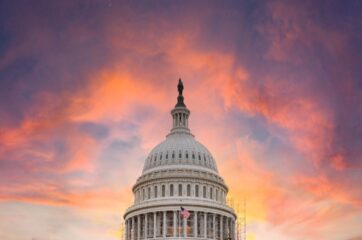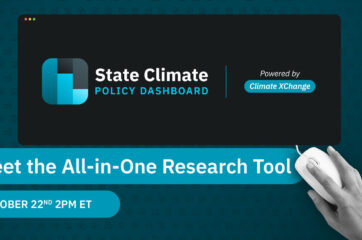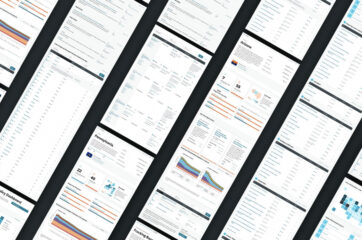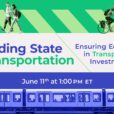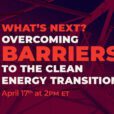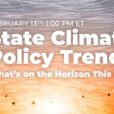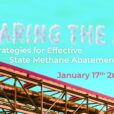With $5 billion in federal funding for climate planning through the Inflation Reduction Act’s Climate Pollution Reduction Grants (CPRG), nearly every state is developing or revising their strategies for reducing greenhouse gas emissions to inform their Priority Climate Action Plan (PCAP). Ensuring that the measures included in each state’s PCAP are science-based, equitable, and ambitious yet feasible is essential to stay on track for Paris-aligned emissions reductions. Further, a robust PCAP sets the stage for each state’s CPRG implementation funding, which is set to be awarded by fall of 2024 and is based on the projects submitted in the PCAP.
We invited a panel of experts to explore tools and best practices for states utilizing CPRG funding for effective and equitable climate planning. Our panel included Phillip Assmus, Senior Policy Specialist at the U.S. Environmental Protection Agency’s (EPA) State and Local Climate and Energy Program; Drew Veysey, Senior Associate at RMI; and Justin Balik, State Program Director at Evergreen Action.
In this recap article, we’ll provide highlights from our expert panel’s presentations and Q&A, including walkthroughs of the EPA’s Quantified Climate Action Measures Directory and RMI’s Energy Policy Simulator (EPS), how such tools can be used for state and local CPRG climate action planning, and how to ensure your state’s PCAP sets you up for a successful implementation.
If you are interested in learning more on how to utilize these tools or best practices for your state or municipality’s climate action plan, reach out to kristen@climate-xchange.org to get connected with these experts.
Phillip Assmus, EPA’s State and Local Climate and Energy Program
Phil Assmus is a Senior Policy Specialist with EPA’s State and Local Climate and Energy Program, which offers state, local, and tribal governments free tools, data, and expertise to help meet their environmental, energy, and economic objectives. Phil serves as the program’s state outreach lead.
What is The Quantified Climate Action Measures Directory?
The Quantified Climate Action Measures Directory presents over 500 examples of quantified climate action measures aimed at reducing emissions, alongside the tools used to quantify these measures, sourced from state and local climate action plans published within the past five years. It includes the following for 270+ state measures and 240+ local measures:
- A summary table of the total number of measures identified, broken down by economic sector and quantification tool, and
- A searchable and sortable table of identified measures, including each measure’s description and type, the emissions reduction quantification tool used, and the jurisdiction of and link to the climate action plan (CAP) it was sourced from, and relevant technical documents with source page numbers.
The directory was created with CPRG in mind, as the program requires participants to assess greenhouse gas (GHG) emission impacts of proposed climate action measures. The tool is intended to make it easy for planning authorities to identify relevant examples of quantified measures and facilitate conversations between entities developing CAPs whose experiences can support each other.
How was the Directory Created?
To develop the directory, EPA reviewed 24 state and 32 local CAPs from the past five years and the tools used to identify and quantify the included GHG reduction measures.
Note: Inclusion of a measure does not imply EPA’s endorsement of any specific measure type, quantification tool, or a measure-level quantification approach. Similarly, the absence of a measure type, tool, or quantification approach should not preclude their inclusion as part of a climate action planning exercise. Measures and related information are summarized from publicly available plans based on EPA’s understanding of the plan, and any errors in these summaries are EPA’s own.
What Types of Measures are in the Directory?
The directory includes 276 state quantified measures and 252 local quantified measures across transportation, commercial and residential buildings, electricity, industry, oil and natural gas systems, natural and working lands, agriculture, and waste and materials management. These sectors generally match the key sectors in CPRG planning guidance, aside from separating oil and natural gas systems out from the industrial sector, and separating agriculture from natural and working lands measures.
View the webinar recording at the top of this article for a visual walkthrough of the directory.
Drew Veysey, RMI
Drew is a senior associate with the Analysis team within RMI’s US Program. His analytical work aids state efforts to implement climate-aligned policies across their economies.
What is the Energy Policy Simulator?
The Energy Policy Simulator (EPS) is a free, open-source tool to evaluate climate policies and visualize their combined impact on emissions, public health, employment, and economic growth. RMI partnered with Energy Innovation to develop EPS state models for the lower 48 states, based on publicly available data and peer-reviewed and transparent methodologies. The EPS offers real-time models of the emissions and economic impacts of individual and combined state policies, also allowing users to build scenarios with their own choice of policy combinations on their web browser, save those scenarios, and download the data.
How Can the EPS be Used for Climate Pollution Reduction Grants?
While the EPS was created long before CPRG, it has turned out to be a potentially extremely useful tool for program participants. The EPS can be used for a variety of CPRG elements, including:
- Quantifying GHG reduction measures, as each measure in the EPS is quantified
- Scoping emissions by source and sector, to assist in building a state’s GHG inventory and identifying where to focus state resources
- Projecting a state’s future emissions through 2050, especially helpful for states without an existing GHG inventory
- Setting GHG reduction targets, with the ability to build scenarios policy-by-policy and compare multiple bottom-up scenarios to hit targets
- Identifying diverse GHG mitigation measures, including dozens of measures in each sector alongside the ability to change the intensity of a policy and schedule of implementation
- Estimating co-benefits, including impacts on air pollution, public health, and the economy
- Engaging communities, as the EPS is free, open to the public, and includes a transparent and documented methodology
If you are interested in learning how to use the state EPS models, view an introductory training recording here.
Justin Balik, Evergreen Action
Justin Balik is the state program director for Evergreen. He has an extensive background in sustainable transportation policy and advocacy, as well as state and local government.
CPRG: An Overview
The Climate Pollution Reduction Grants (CPRG) program, originally written into the Inflation Reduction Act, was designed to stimulate transformation toward a decarbonized economy while demonstrating approaches that are replicable, aiming to accrue benefits to low-income and disadvantaged communities and ensure accountability for climate action planning. The program aims to support measures that achieve long-lasting and certain GHG emissions reductions, especially those for which dedicated funding or financing from other sources is unavailable, or which leverage other sources of public and private funding.
The program is composed of Planning Grants, which provides $250 million of opt-in formula funding for states to develop climate pollution reduction strategies through the development of a Priority Climate Action Plan (PCAP). Subsequently, the program will award $4.6 billion in competitive Implementation Grants for states to implement portions of their PCAPs.
State PCAPs are due to EPA by March 1, 2024, and Implementation Grant applications are due by April 1, 2024. Awards are anticipated to be decided by July 1, 2024 and awarded by October 1, 2024.
Recommendations for CPRG State PCAPs
The CPRG program presents an exciting opportunity for states to undergo the robust planning needed to ensure an effective transition toward a just clean energy economy, focusing funds in the geographies and sectors that need them most. In order to develop a PCAP that meets these objectives, states should:
- Raise ambition, develop new goals, and identify the policies needed to meet them.
- Unify state governments and stakeholders around accelerated and deepened commitments across the most heavily polluting sectors of the economy, including power, transportation, buildings, and industry.
- Target the biggest sources of emissions and gaps in projected progress.
- Understand what existing federal incentives and grants exist to better support proposed ambitious policies. Projects with incentive gaps are powerful places to focus on during the planning process, in addition to identifying approaches to strategically align disparate funding sources.
- Thoroughly engage partners, including municipalities, air pollution control agencies, and Tribal governments, as well as community-based organizations that serve disadvantaged communities.
Recommendations for CPRG Implementation Grant Applications
After states have submitted their PCAPs, they must submit their Implementation Grant application, aiming to fund a portion of the PCAP’s identified measures. As these Implementation grants are competitive, states should prioritize the following to set themselves up as best they can:
- Transform a single economic sector, while linking together opportunities and prioritizing innovation
- Collaborate with other states and develop regional approaches
- Fill gaps to unlock additional federal funding
- Prioritize disadvantaged communities
- Support high-quality, good-paying jobs
- Enact and advance supportive and ambitious state policies:
- Increased clean electricity standards
- New transportation electrification commitments and incentive programs
- Zero-emission appliance standards for space and water heating and all electric building codes
- Industrial facility emissions standards
Q&A
Q: How often will the Quantified Climate Action Measures Directory and the EPS be updated?
Phil Assmus: I’m happy to chime in first. There’s no immediate plans, but that’s largely because we’re kind of in a wait-and-see approach, based on CPRG. So all of the information in the directory is from a pre-CPRG universe. But at this point, certainly at the state level, every climate action plan is a CPRG climate action plan right now. So we won’t have any more data to input until those plans start rolling in. One of the main goals of the directory was to understand how much measure-level quantification had gone on, and how people did it, but when we get further along the CPRG timeline, everyone will have done measure-level quantification, because it’s a required part of the program. So the value proposition actually changes a little bit if we project out further in time. But I am interested in continuing to think about how we can use all of the great inputs we’ll get from both the PCAPs and the CCAPs, the PCAPs being what’s due next year that reflect state state priorities, but also in mid-2025, the CPRG planning grant recipients have their comprehensive plans due, and that’s going to be a pretty key decision point for us, thinking about how to incorporate that information into the directory.
Drew Veysey: The Energy Policy Simulator goes through a major update at least annually to incorporate new data, a lot of our data comes from federal sources like EPA, the Department of Energy, and EIA. Some of these datasets are updated annually, and we always want to be using the most up to date data for our most important datasets. We also do minor updates on the EPS more frequently than annually, to fix bugs, add features, stuff like that.
Q: Who are some key stakeholders to engage in the PCAP development process?
Phil Assmus: I can take a swing at it. I think the answer really depends on who you are. The planning phase of CPRG is really well-calibrated to facilitate big conversations. I tend to think about this as happening on three different levels. There’s the coordination that can and should happen across agencies that exist within the same governmental entity, which doesn’t always happen. So that could be as simple as energy offices talking to air programs, talking to transportation programs. Again, all within the same executive structure. There’s also important conversations to be had up and down the sub-national ladder. There are elements of the CPRG planning grants that are designed to encourage people from the state and municipal levels to work with each other, as much as we can. It’s pretty easy to go to EPA’s website and see the list of who all of the lead organizations are, who directly received the planning grants, but the guidance also goes on to describe how we expect those folks to at least try to coordinate with other people outside of their executive authority. And then obviously, the third dimension of this is stakeholder engagement, and that’s part of the guidance, too. So that’s talking to people who are impacted that are outside of government, but are impacted by these policies and stand to benefit, or bear the costs of them. So, depending upon where you are in those three sets of people, it changes who you need to talk to. But I’d say those are the basic directions that you need to go. And again, the planning grants really do encourage all three of those levels.
Justin Balik: I would add to that by also saying it depends on what sectors you’re going to focus on. If, hypothetically, you’re a state or other entity that wants to go deep on industrial decarbonisation, then you’re going to want to talk to your facility operators, if you’re designing some kind of incentive program that you want to use CPRG Implementation money for. Engaging stakeholders who are bigger, if you’re hoping to drive emissions reductions with whatever implementation funding you are able to receive and execute on, that would also be important, because you want to point towards the ability to credibly and quickly execute on the funding proposal.
Q: What are some reduction measures that you’re particularly excited about, or measures that have a really high impact?
Drew Veysey: So, in my team at RMI, this is one of those questions that we think about all the time and try to look at from multiple angles and dive into which sector, in which state, it matters. We have a blog coming out later today or tomorrow, I’ll make sure that Kristen has it, so that it can be in the follow up email that dives into this. The focus of that is, what is the premier policy by state to get it the furthest? What’s the sweetest opportunity for each state? But also, I’m just a huge fan of clean electricity standards. We have to fix electricity, so I’m a big fan of those.
Justin Balik: I was just going to say, we’ve been working a lot in Michigan lately, so I’m a fan of clean electricity standards. They’re on the mind as something that Evergreen has been working on a lot at the state and federal levels, to decarbonize the power sector. More states are adopting, either in whole or in part, the California transportation electrification standards, and enacting new incentive programs. I would say the combination of standards and investments, regardless of the sector that you’re looking at, is where you can get the most bang for your buck and really transform things. When you’re setting a standard and a goal in law, the regulation for folks to meet, and then also making sure that there’s incentive for people to get there equitably, and affordably, those are the types of that’s the kind of two pronged approach that we tend to get excited about.
Q: Can you provide some thoughts or examples of ways for states and municipalities to coordinate and submit an application together to provide funding for measures?
Phil Assmus: So, that’s something that I’m starting to look at now. One of my CPRG hats within EPA is assembling what we’re calling technical assistance forums, for the grantees to have some kind of technical assistance provided or curated by us, and then also, really importantly, to have opportunities to talk and share with each other. State-municipal coordination is definitely something that we are starting to dig into, to sort of figure out, are there success stories that we can identify? And then, how do we share those practices with the other grantees so that they can benefit from those experiences? Without naming any names, I think some of the most robust stuff I’ve seen is all available online. I mean, you can find a number of states in particular, if only because I think they tend to be better resourced, there are a number of them that have really good websites, that have a lot of good information. They provide notice for their meetings, they have good transparent processes. It’s very clear from reviewing those materials that this is happening. So, you know, the unhelpful part of my answer is, I guess, I’m telling you to build a website, but I’ve seen that work well. Again, I think there are some real success stories out there already, that people, if they hunt for, they can find.
Concluding Thoughts
Justin Balik: I would encourage folks working on this from any facet to think expansively, ambitiously, and creatively. The funding for this type of flexible work is not going to come around very often from the federal government, or it hasn’t in the past, at least. So, it’s a pretty unique opportunity, and we want to make sure it is used for the most impact possible. So, I encourage folks to put on their brainstorming and thinking caps and to think expansively about what’s possible in their own jurisdictions with these resources.
Drew Veysey: I’ll pitch the Energy Policy Simulator, again, it’s free, it’s pretty easy to use, it’s very powerful for how easy it is to use and how free it is, as we were funded by foundations to develop it. So it really democratizes energy and climate modeling, at least, for policy purposes. It’s readily available for use for CPRG or other purposes, whether you’re in state government or outside of it.
Philip Assmus: I’ll just close by emphasizing what an exciting time this is for climate action planning. Just pulling the state numbers, historically, we know that 33 states have done climate action plans, only 25 have done them within the last five to ten years. The CPRG state grantees are 46. So we have a number of states that have never done a climate action plan before, and states that maybe have but haven’t done one for many administrations. And it’s really exciting to have this kind of collaborative, inclusive, positive program standing up with a lot of support from outside the agency too, frankly. I think it’s really fun, and it’s exciting, and I appreciate the chance today to share a little bit about the directory to support that work.
* The views and opinions expressed by our guest speakers during the webinar and summarized in this article are their own and do not necessarily reflect the views or positions of Climate XChange.

